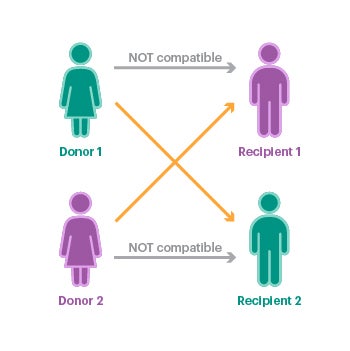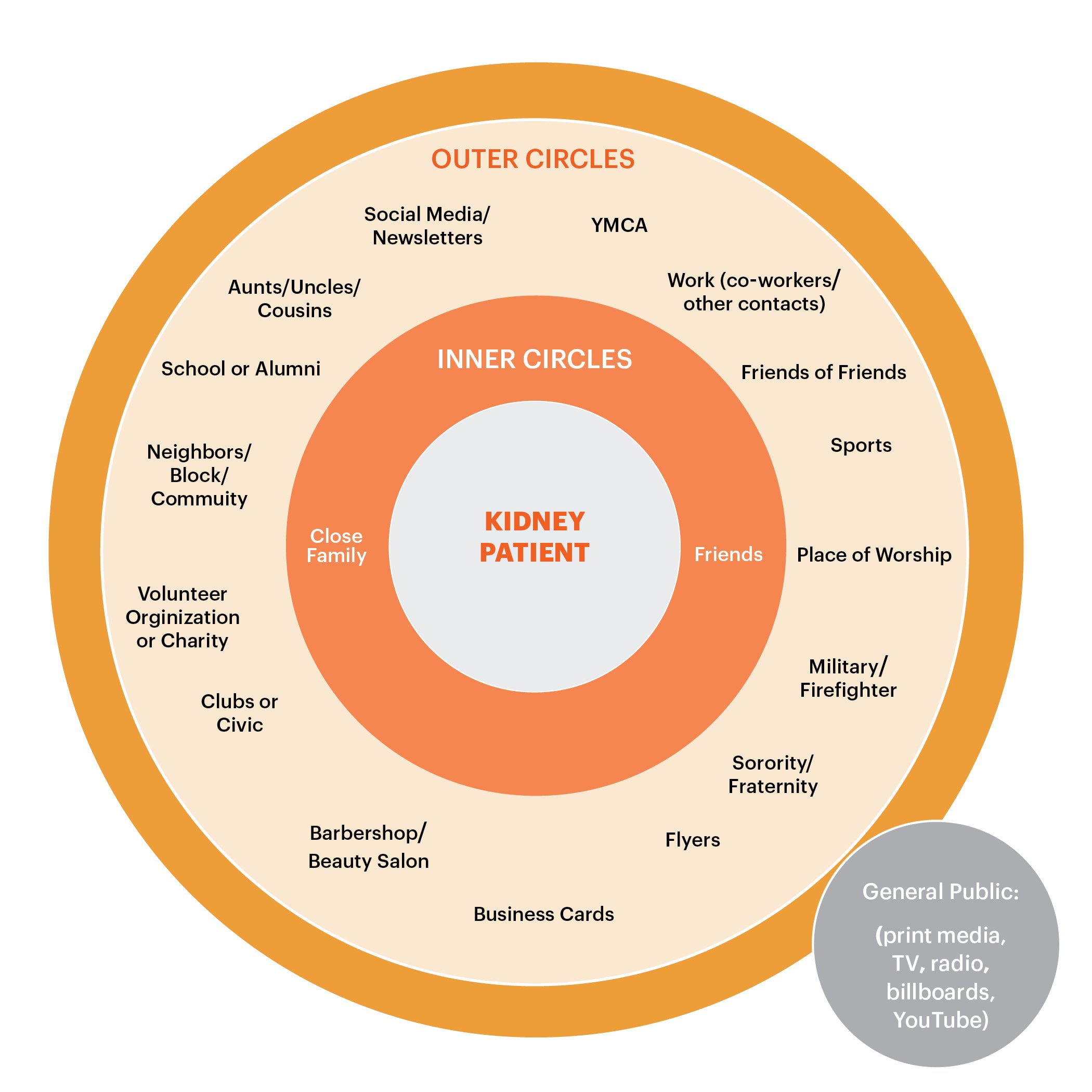Last updated: March 29, 2024
Medically reviewed by: NKF Patient Education Team
Explore the benefits, types, and process of getting a kidney from a living donor, including costs, finding a donor, and key questions for your healthcare team.
Table of Contents
- About living donor kidney transplant
- Benefits of getting a kidney from a living donor
- Types
- Who can be a living kidney donor?
- How it works: steps to becoming a living donor
- What it costs to be a living donor
- If your donor is not a match
- When to start looking for a living donor
- How to find a living kidney donor
- Questions for your healthcare team
- More resources
About living donor kidney transplant
Living donation is when a living person donates a kidney to another person who has kidney failure, called the recipient. The living donor can be a family member, such as a parent, child, brother or sister (living related donation). Living donors can also be someone who is not a blood relative, such as a friend of a friend, coworker, fellow member at their place of worship, neighbor or someone that hears through social media – even a stranger.
Kidneys from living or deceased donors both work well and can be good options, but kidneys from a living donor may last longer and are more likely to start working right away than a kidney from a deceased donor. Also, when a kidney is donated by a living person, the operations can be scheduled at a good time for both you and the donor. Finding a living donor can also help you get a kidney faster since waiting for a deceased donor kidney can take many years.
Benefits of getting a kidney from a living donor
If you get a kidney transplant from a living donor, there are a few benefits compared to a kidney from a deceased donor:
- A shorter wait – Having a living donor means you no longer have to wait on dialysis. If you have kidney failure and can find a donor before you need dialysis, you may be able to get a preemptive transplant, meaning you don’t have to go on dialysis at all.
- A better match and outcomes – A better match reduces the risk of rejection. Some living donor transplants are done between family members who are genetically similar, but you can be a great match with someone you are not related to.
- Lasts longer - On average, a kidney from a living donor lasts about 15 to 20 years, compared to 7 to 10 years for a kidney from a deceased donor. Some will last longer; others will last less. Also, living donor kidneys often do better than deceased donor kidneys, such as working right away.
- Better timing – With a living donor, it is possible to plan the surgery day and time at a time that works best for the pair and the transplant team. This way, both the kidney patient and their living donor can be at their healthiest.
The risks of a kidney transplant are basically the same whether you get a kidney from a living donor or from a deceased donor.
Types
There are two types of living kidney donation:
- Directed Donation is when the donor names a specific person who will receive the kidney. It is the most common type of living donation. Directed donations can be between blood relatives, like parents, siblings, or children. They can also happen between people with close personal relationships, such as a spouse, friend, or coworker.
- Non-directed donation is when a person does not name a specific person who will get their kidney or have a relationship with the person who gets the donated kidney. In this case, the donor is paired with someone in need of a kidney on the transplant waitlist. Other names for a non-directed donor include altruistic or “good Samaritan” donor.
Who can be a living kidney donor?
All living kidneys donors must be at least 18 years old to donate in the United States. Some transplant centers require a donor to be 21 or a little older. There are also some centers that have an age limit for older adults. Some medical conditions could prevent someone from being a living donor, including having uncontrolled high blood pressure, cancer, HIV, or hepatitis (also called contraindications). You should always let the transplant center decide who can be a living donor.
How it works: steps to becoming a living donor
If someone is interested in becoming a living donor, the first step in the process is to contact a transplant center and complete an evaluation. Just like a patient who needs a kidney, donors go through a medical evaluation and have other tests done to make sure they are healthy enough to donate and have the support they need. For more information on becoming a living kidney donor, visit the General Information on Living Donation page.
It may surprise you to know that life after donating a kidney is basically the same as life before donating a kidney! Donating a kidney does not mean the donor will live for a shorter time or have kidney problems later on. People who donate a kidney can still have children without problems, though women who want to become pregnant should wait at least six months after the surgery to let their body fully recover and talk to their doctor before becoming pregnant.
To learn more about life after donating a kidney, visit the What to Expect After Donation page.
What it costs to be a living donor
A living donor’s medical expenses, including evaluation and surgery, are covered by the recipient’s health insurance, no matter if they know each other or not. However, health insurance usually doesn’t cover the donor’s time off from work, travel expenses, or lodging related to donation. The National Living Donor Assistance Center and other programs may help cover the donor’s travel and lodging costs. You should ask your transplant social worker about any financial programs through the transplant center, state, or national level that you or your donor might qualify for.
If your donor is not a match
During the evaluation, the transplant center will do tests for “compatibility” between the kidney patient and the living donor. These tests check how well the donated kidney will do in the recipient’s body based on each person’s blood type and other factors. Even if the recipient and the donor are not related by blood, they can still be a good match.
Even if the living donor is not a good match for the person they want to donate to, donors can still help the recipient get a living donor transplant by donating through a paired exchange program. Paired exchange helps match up donor pairs and “switch” them for a better match. The transplant center will talk to you about your options.

When to start looking for a living donor
At most transplant centers, you will need to finish your evaluation before they will consider anyone who is interested in donating to you. Most people who are interested in having a living donor transplant start sharing their need for a kidney when they are approved for a transplant, at the end of the evaluation.
Some people are even able to get a living donor transplant before they need to start dialysis, which is called an early or preemptive transplant. Even though dialysis is a treatment option, it can be hard on your body, so spending as little time as possible on dialysis is the healthiest option for most patients.
How to find a living kidney donor
Most people are not comfortable directly asking someone to donate. Think of it more as sharing how you’ve been doing, that you need a kidney transplant, and that your doctors have said that a living donor kidney is the best and healthiest option for you. That way, if someone is interested in getting evaluated or wants to learn more, they can.
A good place to start the conversation is with family, friends, and then more broadly as you feel comfortable, to include:
- Co-workers, community organizations, and social groups
- People who belong to your place of worship
- Local newspapers or magazines
- Social media to share your story

Many people looking for a living donor also ask their friends and family to share that they need a kidney with their communities and groups that they’re involved with. The more people who know you are in need, the more likely it is that someone will come forward to be your living donor.
Anyone who is interested in donating to you can contact your transplant center (and ask for the “Living Donor Transplant Coordinator”) for more information and to begin the evaluation process. Visit the How to Donate page to learn more.
Questions for your healthcare team
- Does your center have any paired exchange programs for incompatible pairs?
- Internally or externally through the National Kidney Registry?
- Does your center have remote donation through NKR if someone lives far away but wants to donate to me?
- What kind of financial assistance programs would my donor qualify for to cover expenses not paid for by my insurance?
- Transplant center programs
- Donor shield through NKR
- State programs
- National programs, like NLDAC
- What is the health questionnaire web link for a potential donor to start the evaluation process?